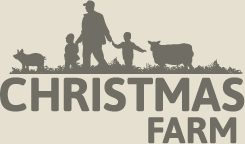
Christmas comes but once a year, and we all enjoy the feasting and food that goes along with the celebrations here at Christmas Farm.
Here are our top tips for making the most of your festive ingredients.
Cooking your turkey
- After stuffing your organic turkey, weigh it to calculate the cooking time. We like to stuff the neck and body cavity.
- Pre-heat your oven to 220°C/gas mark 7
- Put a tablespoon of flour in a roasting tin and place your turkey on top.
- Rub the turkey all over with softened butter or olive oil.
- Season well with salt and pepper.
- To protect the thigh and breast meat, cover with streaky bacon, or a double layer of muslin, then foil.
- Roast your turkey in the pre-heated oven for 30 minutes.
- Then reduce the heat to 180°C/gas mark 4 for birds up to 5.5kg or 160°C/gas mark 2-3 for larger birds over 5.5kg.
Roasting times – including the first 30 minutes:
- 3.5 to 4.5kg – 3 to 3.5 hours
- 4.5 to 6.4kg – 3.5 to 4 hours
- 6.4 to 8.2kg – 4 to 4.5 hours
- 8.2 to 9.1kg – 4.5 to 5 hours
Remove the foil for the last 30 minutes.
Test your turkey to see if it is cooked by inserting a skewer into the thickest part of the thigh. If the juices run clear, then it’s ready.
Remove your organic turkey from the oven and cover it with foil and tea towels to keep it warm. Allow it to rest for at least 30 minutes before carving.
Cooking your goose
- Roast your goose at 240°C/fan 220°C/gas mark 9 for 10 minutes.
Then reduce the oven temperature to 190°C/fan 170°C/gas mark 5 and cook for:
- 20 minutes per kg for medium-rare
- 32 minutes per kg for well-done
Allow your goose to rest for 3o minutes before carving.
How to carve your goose
Goose breasts are shallow, so take a sharp, long, thin-bladed knife and angle it at about 90 degrees to the breastbone, carving from the neck end.
Detach the legs, then slice off the thigh meat.
Hams and bacon
 We cure our hams and bacon using time, salt and sugar. We don’t add any chemicals to speed up the process or to keep meat looking ‘pink’ once cooked.
We cure our hams and bacon using time, salt and sugar. We don’t add any chemicals to speed up the process or to keep meat looking ‘pink’ once cooked.
So, to avoid more saltiness than conventional bacon, we recommend soaking the bacon for a few hours and the hams overnight in cold water before cooking.
Change the water after the first hour, when most salt will be drawn out of the meat.
We usually boil our Christmas ham and leave it to cool on Christmas Eve. Then peel off the skin, leaving as much fat as possible, before adding a glaze and roasting for 20 minutes to get a nice crust about an hour before serving.
This keeps the ham moist and also makes carving easy, as the meat can rest and soak up any juices that have trickled through the glaze.
There are loads of good ham glaze recipes online, but you can’t go far wrong with some homemade marmalade, brown sugar and olive oil whizzed up and pasted on the ham with the back of a fork.
Christmas puddings
Beth’s home-made Christmas puddings have already been steamed for hours and just need reheating to serve.
Pop your Christmas pudding in the microwave on medium for 3-5mins, depending on your power setting. Or steam your pudding for 30 minutes until piping hot.
Delicious served with brandy sauce or cream.
Sausage meat stuffing
You will also have some sausage meat in your Christmas box. This is our standard sausage mix, so doesn’t contain a lot of breadcrumbs or spices.
You can bake it as is, in the tray it comes in if you like. Or use it as a base for your own stuffing recipe, adding breadcrumbs, chestnuts or fruit depending on your taste.
We often like it pressed into burger shapes and fried as breakfast patties too.

Comments are closed.